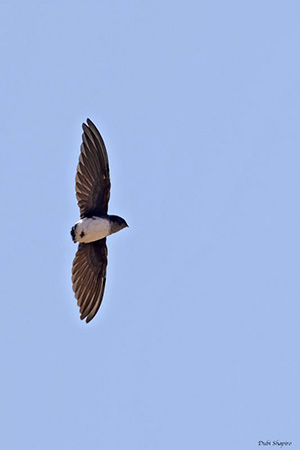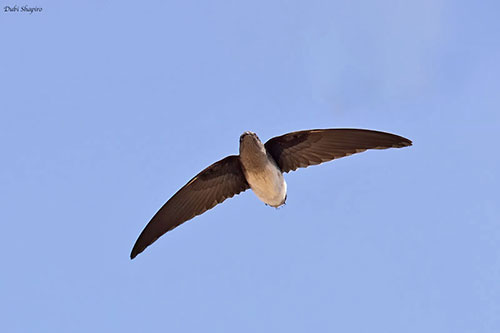
Fr: Martinet de Böhm
Ang: Bat-like Spinetail or Böhm's Spinetail
All: Fledermaussegler
Esp: Vencejo de Böhm
Ita: Rondone codaspinosa pipistrello
Nd: Böhms Gierzwaluw
Sd: Böhms taggstjärtseglare
Photographer:
Dubi Shapiro
Dubi Shapiro Photo Galleries
Text by Nicole Bouglouan
Sources:
HANDBOOK OF THE BIRDS OF THE WORLD Vol 5 by Josep del Hoyo-Andrew Elliott-Jordi Sargatal - Lynx Edicions - ISBN: 8487334253
Swifts: A Guide to the Swifts and Treeswifts of the World, Second Edition Hardcover – January 1, 1995 – By Phil Chantler – Pica Press – ISBN: 0300079362 – 978-0300079364 – 237 pages
Wikipedia, the free encyclopaedia
Bat-like Spinetail or Böhm's Spinetail
Neafrapus boehmi
Apodiformes Order – Apodidae Family
INTRODUCTION:
The Bat-like Spinetail or Böhm's Spinetail is a tiny, short-tailed spinetail, often considered the most distinctive of all African spinetails.
This species is widely scattered in sub-Saharan range, especially in SW, E and SE Africa. Two subspecies share this range.
It is mainly found in lowland, below 600 metres of elevation, sometimes higher depending on the area. It usually frequents primary savanna woodlands, often open and arid, with deciduous tree species. But it is also found at the edges and in clearings in denser evergreen forest. It feeds on insects caught in flight, often close to large trees.
The Bat-like Spinetail or Böhm's Spinetail is monogamous and solitary nester. The eggs are laid in a U-shaped structure placed 3-9 metres below the ground in shaft, pit or well, amongst Brachystegia woodland. Both adults share the nesting duties.
The Bat-like Spinetail or Böhm's Spinetail is considered the rarest white-rumped spinetail of Africa. It is described as locally common and often rare. It is affected by habitat loss. However, currently, the species is not globally threatened.
The name of this species pays tribute to the German zoologist and explorer Richard Böhm (1854-1884).

DESCRIPTION OF THE BIRD:
Biometrics:
Length: 10 cm
Weight: 14-15 g
The Bat-like Spinetail or Böhm's Spinetail has uniformly black-brown upperparts, with bronze sheen from crown to lower back. The broad, white rump contrast strongly with both dark back and uppertail-coverts.
The upperwing is black-brown too, with blue gloss on some coverts. The smaller coverts are black. The wings are very wide compared to the size of the bird.
The short tail is black-brown with narrow, whitish tip. The outer rectrices are edged white. Each rectrice has shaft spines projecting 2,5/3,5 millimetres beyond the webs.
The underparts are white from lower breast to undertail-coverts. The upper breast is grey. The undertail is greyish. On the underwing, the coverts are darker than the flight-feathers.
On the head, forehead and lores are brown, but the feathers over the eye have grey fringes. The crown is black-brown with bronze gloss. The ear-coverts are similar but paler on the lower part. Chin, throat and upper breast are mottled grey, slightly darker on breast and breast sides.
The bill is black. The eyes are brown. The very short legs and the feet are blackish.
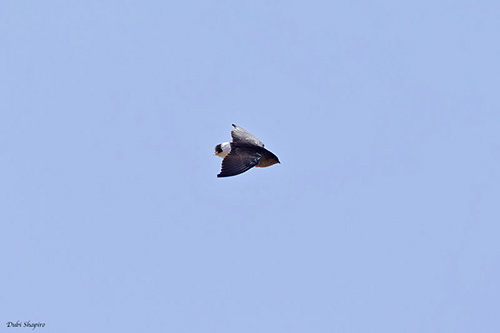
Male and female are similar.
The juvenile resemble adult in fresh plumage.
SUBSPECIES AND RANGE:
The Bat-like Spinetail or Böhm's Spinetail has two subspecies.
N.b. boehmi (described above) is found in W and CE Angola, S DRCongo, W and N Zambia and W Tanzania.
N.b. sheppardi occurs in SE Kenya and E Tanzania, E and SE Zambia and W Tanzania.
This race is slightly smaller than nominate. The lower throat is paler and the shafts on the underparts are more obvious. The rump shows dark shaft streaks (missing in nominate). In fresh plumage, the primaries have white fringes on the outer webs.
HABITAT:
The Bat-like Spinetail or Böhm's Spinetail usually frequents primary savanna woodlands, often open and arid with deciduous tree species such as baobabs, miombo and others. It is also found at edges and in clearings in dense evergreen forest. It usually occurs below 600 metres of elevation, but sometimes up to 900 m in Zimbabwe and 1300 m in Tanzania.
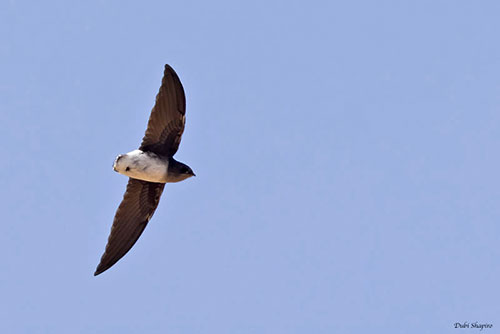
CALLS AND SONGS: SOUNDS BY XENO-CANTO
The Bat-like Spinetail or Böhm's Spinetail gives an undulating twitter described as “Tir-it-treetree” or “Ti-tititeitei”. There is some emphasis on the first note, sometimes heard alone “Ti” or “Tit”.
We can also hear a high-pitched “srree-srree-seeep”.
BEHAVIOUR IN THE WILD:
The Bat-like Spinetail or Böhm's Spinetail feeds mainly on insects such as beetles, flies and flying ants. The prey are caught by hawking while flying low over the tree canopy. It joins mixed-species foraging flocks, but it is often seen alone.
The species is monogamous and solitary nester. Both adults build a U-shaped nest placed in subterranean pits or wells, several metres below the ground. Both adults share all the nesting duties.
It is the only Old World swift known to breed on underground sites.
The Bat-like Spinetail or Böhm's Spinetail is resident throughout the range, with probably some local movements in some regions (Zambia and Zimbabwe), related to weather conditions and food resources.
The flight of this species may appear uncertain. All manoeuvres are performed with movements of both wings in unison. Corrections up or down are made in one wing, while the other compensates by an opposite movement.
Changes of direction are sometimes achieved by holding one wing still, while the other is flapping vigorously. The whole action is often erratic. The aerial abilities of these birds are restricted by the very short tail.
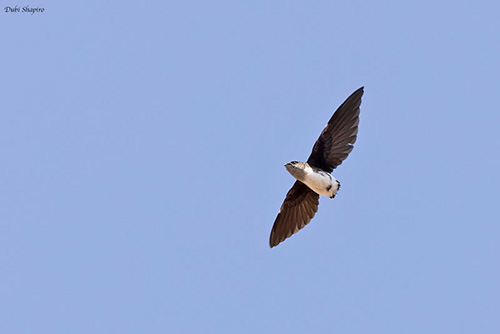
REPRODUCTION OF THIS SPECIES:
The egg-laying period varies according to the range: January or February in Kenya, April in Tanzania, October in DR Congo, September, October and January in Zambia and April in South Africa.
The Bat-like Spinetail or Böhm's Spinetail is monogamous and solitary nester. Both adults build a U-shaped nest with a central cup made with thin twigs and lined with some feathers or wood chips. It is 6-8 cm wide and 2,5-6,5 cm deep. This structure is often stuck on an area of slight overhang, 3 to 9 metres below the ground in a shaft, pit or well, usually amongst Brachystegia woodland.
Some birds have been seen leaving hollows in Baobab trees, but they probably use them as roosting sites.
The female lays 2-3 white eggs and both adults incubate during about 14 days. They incubate facing the wall. The young are fed by both parents. They are feathered three weeks after hatching, and they may leave the nest at about four weeks old (maybe later). They cling to the adjacent wall when leaving the nest. They are able to fly at 5-6 weeks old.
PROTECTION / THREATS / STATUS:
The Bat-like Spinetail or Böhm's Spinetail is highly localized and nowhere considered more than locally common, and even often rare throughout much of its range.
The size of the population is unknown, but it is suspected to be declining due to habitat loss. However, the species is not considered globally threatened, and the Bat-like Spinetail or Böhm's Spinetail is currently evaluated as Least Concern.
